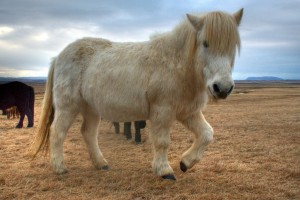I’m reading a lot of Icelandic history, lately, and came across this fine description of the Icelandic horse in Magnus Magnusson’s Icelandic Saga. It sounds very like the sturdy little native ponies I saw in Wales:
Physical communications were daunting. Torrential rivers, formidable mountains, impassable reaches of lava and huge distances were forbidding obstacles to social intercourse. But the settlers from Norway brought with them a creature which made light of difficulty and distance ― the hardy, nimble-footed Icelandic horse, the pure-bred equus scandinavicus. It was as important a catalyst for settlement by land as the knörr was by sea. Sturdy and docile, the horse carried everyone and everything on its back ― and continued to do so, indeed, for a 1,000 years; the first road for wheeled vehicles was not built in Iceland until 1874. The Icelandic horse has not changed in the slightest over the centuries; it has never interbred with foreign stock, and it is still the original Nordic horse. It has a unique range of five gaits: step (fetgangur), trot (brokk), gallop (stökk), pace (skeið), and running walk, or rack (tölt); this is the distinctive gait of the Icelandic horse, setting it apart from other European breeds ― the rider sits perfectly still in the saddle, while the horse positively glides along. Horse-riding in Iceland is now a pleasure and a sport rather than a necessity; to own a herd of free-running horses is something of a status symbol. There are some 90,000 horses in Iceland now (one for every three of the human population), adding romance and glamour to the landscape as they range free in the upland pastures. In the long Iceland Saga the bond between man and horse hasw always been close and affectionate.
It was possible to cover tremendous distances on the rugged Icelandic landscape with these animals. Consequently, any farmer could attend the Allthing, the parliament of the medieval Icelandic republic. This had the peculiar effect of turning a completely non-urban society (there were not even villages or hamlets, only isolated farmsteads) into the equivalent of a city state. For it is clear from the sagas that the personal and political interaction between these far-flung settlers was as intimate as in any Greek city. Realizing this adds a dimension to our understanding of polities.

0 Comments.